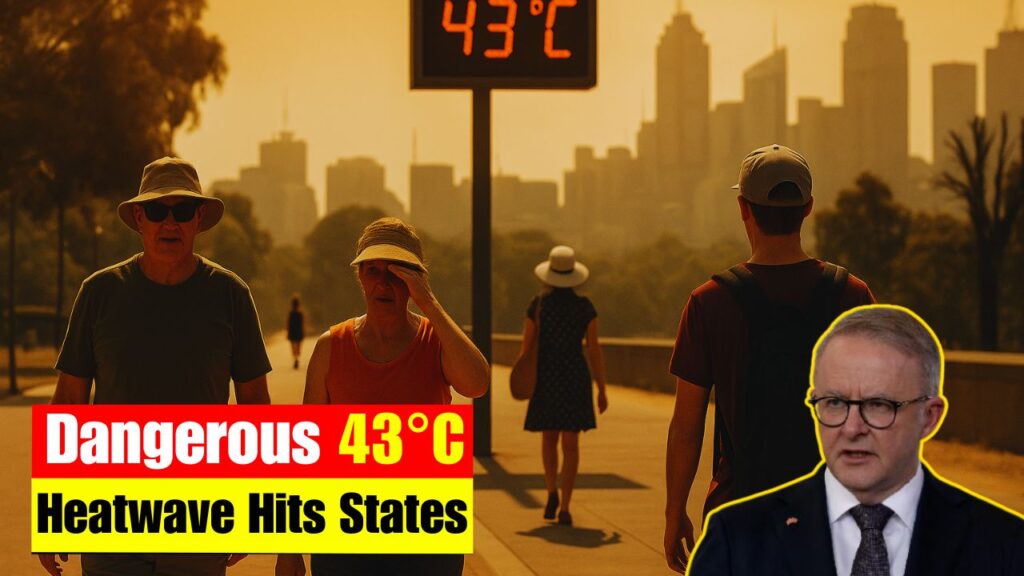Australia 4-Day Heatwave November – Australia is preparing for an intense four-day heatwave beginning on 27 November, with forecasts showing temperatures climbing dangerously close to 43°C across several major states. This severe weather alert has prompted authorities to warn residents about rising health risks, bushfire dangers, and potential disruptions to daily routines. As heat extremes become more common across the country, Australians are being urged to follow safety guidelines, stay hydrated, and monitor updates closely. This article explains the full heatwave details, key safety measures, and what citizens can expect during this high-temperature event.

Extreme Heatwave Conditions for Australian Citizens
The upcoming extreme heatwave is expected to affect Australian citizens living across New South Wales, Queensland, Victoria, and South Australia. Meteorologists confirm that hot, dry winds will push temperatures up to 43°C, significantly increasing the threat of heat-related illnesses. Residents are being advised to limit outdoor work, keep living spaces cool, and check on vulnerable people such as seniors and young children. Emergency services across the country are preparing for a surge in heat-related calls as the four-day temperature spike intensifies. This keyword variation highlights the seriousness of the event for people living in Australia.
 Australia Introduces $415 Rolling-Red Fine – AI Red-Light Cameras Now Catching Drivers Instantly
Australia Introduces $415 Rolling-Red Fine – AI Red-Light Cameras Now Catching Drivers Instantly
High Temperature Surge Across Australia
This high temperature surge across Australia is driven by a strong heat dome settling over the inland regions and extending towards the coastal areas. Weather experts report that multiple states will face extreme UV levels, making sun exposure highly risky throughout the day. The heatwave beginning 27 November is expected to push electricity demand higher as households rely on cooling systems for comfort and safety. Australians are encouraged to follow official alerts from the Bureau of Meteorology and prepare emergency kits. This section emphasises rising temperatures and the national response required to manage them.
| State/Region | Expected Peak Temperature |
|---|---|
| New South Wales | 41°C – 43°C |
| Queensland | 39°C – 42°C |
| South Australia | 40°C – 43°C |
| Victoria | 38°C – 41°C |
| Northern Territory | 42°C – 44°C |
Severe Weather Impact for People Across the Australian States
The severe weather impact for people across the Australian states will extend beyond discomfort, potentially affecting transportation, workplaces, and outdoor events. Heatwaves of this scale often trigger increased bushfire activity, prompting emergency warnings in high-risk zones. Authorities urge communities to create fire-ready plans, avoid unnecessary travel during peak heat hours, and conserve water as demand increases rapidly. Schools and public spaces may adjust operating schedules if temperatures rise beyond safe limits. This section focuses on how different regions and their residents will experience the consequences of prolonged high temperatures.
Heat Safety Measures for Residents Across Australia
Heat safety measures for residents across Australia are essential as the country prepares for extreme temperatures. Officials recommend staying indoors during the hottest parts of the day, wearing light clothing, drinking plenty of water, and avoiding strenuous activities. Households should ensure pets are kept cool and have access to shade and water. People living alone, particularly seniors, are encouraged to stay connected with neighbours or family to reduce risks. These precautions help minimise health concerns and strengthen community resilience during the upcoming heatwave.
Frequently Asked Questions (FAQs)
 Centrelink’s November 2025 $250 Relief Payment – One-Off Boost for Age Pensioners Nationwide
Centrelink’s November 2025 $250 Relief Payment – One-Off Boost for Age Pensioners Nationwide
1. When does the heatwave start in Australia?
The heatwave begins on 27 November and is expected to last four days.
2. Which states will face the highest temperatures?
New South Wales, Queensland, South Australia, and the Northern Territory may see temperatures near 43°C.
3. How can Australians stay safe during the heatwave?
Residents should stay hydrated, avoid peak heat hours, use cooling systems, and monitor weather updates.
4. Will public services be affected during the heatwave?
Some services such as schools, public events, and transport may adjust schedules depending on heat severity.


